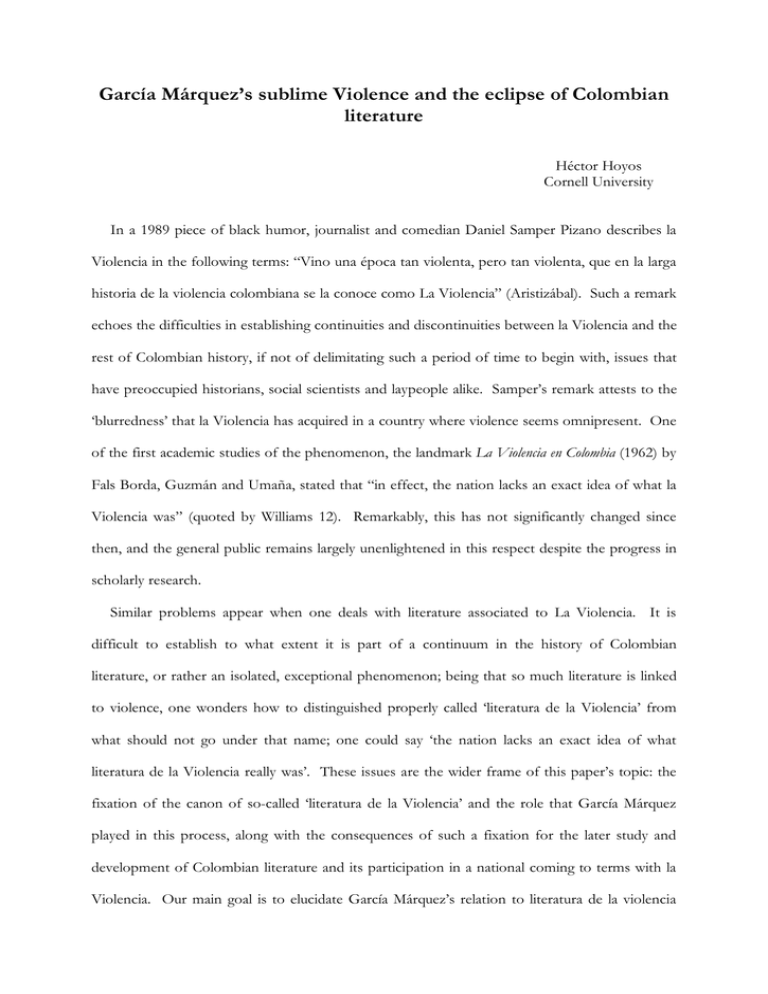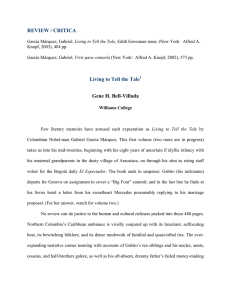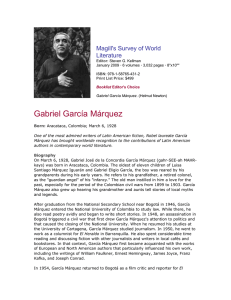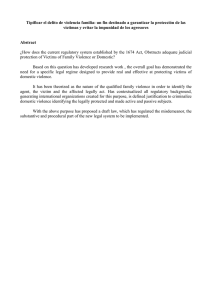García Márquez`s sublime Violence and the eclipse
Anuncio

García Márquez’s sublime Violence and the eclipse of Colombian literature Héctor Hoyos Cornell University In a 1989 piece of black humor, journalist and comedian Daniel Samper Pizano describes la Violencia in the following terms: “Vino una época tan violenta, pero tan violenta, que en la larga historia de la violencia colombiana se la conoce como La Violencia” (Aristizábal). Such a remark echoes the difficulties in establishing continuities and discontinuities between la Violencia and the rest of Colombian history, if not of delimitating such a period of time to begin with, issues that have preoccupied historians, social scientists and laypeople alike. Samper’s remark attests to the ‘blurredness’ that la Violencia has acquired in a country where violence seems omnipresent. One of the first academic studies of the phenomenon, the landmark La Violencia en Colombia (1962) by Fals Borda, Guzmán and Umaña, stated that “in effect, the nation lacks an exact idea of what la Violencia was” (quoted by Williams 12). Remarkably, this has not significantly changed since then, and the general public remains largely unenlightened in this respect despite the progress in scholarly research. Similar problems appear when one deals with literature associated to La Violencia. It is difficult to establish to what extent it is part of a continuum in the history of Colombian literature, or rather an isolated, exceptional phenomenon; being that so much literature is linked to violence, one wonders how to distinguished properly called ‘literatura de la Violencia’ from what should not go under that name; one could say ‘the nation lacks an exact idea of what literatura de la Violencia really was’. These issues are the wider frame of this paper’s topic: the fixation of the canon of so-called ‘literatura de la Violencia’ and the role that García Márquez played in this process, along with the consequences of such a fixation for the later study and development of Colombian literature and its participation in a national coming to terms with la Violencia. Our main goal is to elucidate García Márquez’s relation to literatura de la violencia and to put forward the hypothesis that under the light of this complex relation one can better understand the ‘eclipse of the rest of Colombian literature’, that is, its negation and exclusion from both national and international mainstream reception. One can follow Samper in asking the (rhetorical) question ‘how violent was la Violencia for it to be ‘so violent that it is known as la Violencia’?’ An estimate of 200,000 people dead and over two million displaced between 1946 and 1966 gives a partial idea of how profound an impact it had on the lives of Colombians (Roldán 22; 380 n. 2). Likewise, its persistence in the collective imaginary is illustrated by the odd result shown by field-work, that when asked for the violence in the 80s victims tend to go back and talk about events that took place during la Violencia (ibidem 347). Inevitably, such events have made a profound impact on Colombian literature. Three aspects of the name ‘la Violencia’ illustrate some of the general tasks undertaken by writers of the period. The term is vague enough to avoid a confrontation of historical responsibilities, imprecise enough to match the lack of a generally accepted framework for its proper comprehension, and lastly, chilling enough to bring about its uncanniness (following Peñaranda in Bergquist 294). These aspects coincide with what was demanded from ‘literatura de la violencia’, respectively: denouncing perpetrators, offering an explanation of the phenomenon and giving voice to its ineffable fear. The first wave of ‘novelas de la violencia’ answer to these demands following similar narrative strategies. They correspond to the first stage of la Violencia, that is, from its beginning in Ospina’s repressive government (1946) until the milestone of Rojas Pinilla’s military coup of 1953. These novels are actively involved in the political dispute, take sides, point at presumed perpetrators and serve as a ‘memorial de agravios’, a record of crimes committed. There were many novels written by liberals that held the conservatives responsible for the mayhem, and also fewer conservative ‘counter-novels’ that defended the ruling party, such as Las balas de la ley (1953) by Alfonso Hilarión Sánchez. In Raymond L. Williams words, “[m]any of the earlier novels of la Violencia had been documentary in impulse and frequently laden with crude violence”. (49) This documentary impulse served both the demand of denouncing and that 2 of explaining, for writers frequently found in specific characters of Colombian politics the ultimate cause for la Violencia, as is the case with ‘El Monstruo’ (1955) by Carlos H. Pareja, where presumed all-evil conservative leader Laureano Gómez is the alluded to ‘monster’. The third demand of giving voice to the irrational fear is one that compromised the aesthetic-political project of the early novel of la Violencia. Realistic and detailed descriptions of sadistic acts, which were intended as a means of denouncing and keeping track of what was being hidden by the official discourse, ended up themselves becoming a sado-masochistic practice. The early novel of la Violencia compulsively played out the on-going trauma. In a 1959 article titled ‘Dos o tres cosas sobre ‘la novela de la Violencia’’ García Márquez expresses a position that in a toned down version would become common knowledge whenever the early novelists of la Violencia are mentioned: Apabullados por el material de que disponían, se los tragó la tierra en la descripción de la masacre, sin permitirse una pausa que les habría servido para preguntarse si lo más importante, humana y por tanto literariamente, eran los muertos o los vivos. El exhaustivo inventario de los decapitados, los castrados, las mujeres violadas, los sexos esparcidos y las tripas sacadas, y la descripción minuciosa de la crueldad con que se cometieron esos crímenes, no era probablemente el camino que llevaba a la novela. (287, my emphasis) The generally accepted view is that this group of novels is unbearably and uselessly gory, up to a point that instead of shocking the reader, they render the latter insensible to what is being told. García Márquez goes one step beyond this, implying that they ‘fail in the path that leads to the novel’. In other words, they are not really novels to begin with. What are they then? García Márquez doesn’t even consider that having personally read at least a good number of them is necessary to give credit to their overall uselessness, and he writes ‘two or three things’ about the subject, certainly because they are not worth while writing a fourth one. He writes the article for the magazine La calle in October 1959, in response to the question of why he had not written a politically engaged novel about la Violencia. As is common in his interviews, articles and essays, García Márquez’s political position is not easy to pin down. In the article he dwells on this uncertainty by at the same time making an aestheticist move towards ‘a better literary use of an exciting subject’, claiming that a novel on this subject should care more about the living than 3 about the dead -and here one would think about the victims- yet lastly saying that the pathos of the perpetrators should not be forgotten: Quienes vuelvan alguna vez sobre el tema de la violencia en Colombia, tendrán que reconocer que el drama de ese tiempo no era sólo el del perseguido, sino también el del perseguidor. Que por lo menos una vez, frente al cadáver destrozado del pobre campesino, debió coincidir el pobre policía de a ochenta pesos, sintiendo miedo de matar, pero matando para evitar que lo mataran. Porque no hay drama humano que pueda ser definitivamente unilateral. (288-9) In other words, García Márquez is echoing the ecumenism of his day, the demand for peace, reconciliation and oblivion. So important is this last element that there is no mention of the person that ordered this ‘pobre policía de a ochenta pesos’ to shoot. It is noteworthy that this position serves the purpose of offering a contrast to the great deal of partisan novels that were used as weapons of war. In a fundamental 1966 study, La novela sobre la violencia en Colombia, Gerardo Suárez Rondón makes a list of over 50 such novels, including those written with the second stage of la Violencia in mind, summarizing their arguments and arriving at the conclusion that, indeed, most of them are as bad examples of pièce à these as García Márquez supposed. A similar conclusion is reached in later studies by Isaías Peña Gutiérrez, Raymond L. Williams and Seymour Menton. These critics do recognize the literary worth of some novelas de la violencia, and make exceptions in their umbrella judgments of disapproval that García Márquez does not, neither in this article nor in the 1960 ‘La literatura colombiana, un fraude a la nación’, a masterful piece of self-inclusion in the canon. Is perhaps García Márquez unaware of the existence of wellachieved literatura de la violencia? This is certainly not the case. In 1951 Argentinian Editorial Losada agreed to publish El cristo de espaldas by Eduardo Caballero Calderón, while rejecting García Márquez’s The Leaf Storm with a note “in which he was told that he was not fit for writing, and instead he’d be better off in some other job” (Sorela, Pedro. El otro García Márquez. Los años difíciles. Bogotá: Oveja Negra, 1989, p.24, quoted in GGM 1991, Cruz 80). Caballero Calderón’s first novela de la violencia is far from being the kind of novel that García Márquez could say but two or three things about. Instead, he does not even mention it. By the time the article appears, Caballero Calderón has 4 also published Siervo sin tierra (1954) and is preparing Manuel Pacho (1962). In fact, all three novels are well-written pieces, even if they are presumably closer in technique to the traditional ‘cuadro de costumbres’ than they are to Camus’s La Peste, a text that García Márquez recommends as an exemplary way of ‘writing about the living instead of the dead and making use of a great theme by successfully building an intriguing plot that adequately reflects the fear felt by people in grave distress’ (287-8). García Márquez wishes to inscribe himself in the broader history of universal literature, carefully drawing lines of kinship between his works and Camus, Hemingway or Faulkner’s, instead of inscribing himself in the ‘smaller pond’ of Colombian literature. Indeed, he will utterly succeed in this task, and is considered more of a ‘universal’ author than a local Colombian one. He feels a need to find a tradition elsewhere and ‘learn how to write about such a subject’ to finally offer that groundbreaking, mature novela de la violencia: “La aparición de esa gran novela es inevitable, en una segunda vuelta de ganadores.” (289) García Márquez makes no mention whatsoever of the short stories by Hernando Téllez or Manuel Mejía Vallejo. He could have said that although no satisfactory novel of the Violence was at hand, certain short stories could be reviewed. Instead, he ‘incorporates’ them into his own. In his The Funerals of the Great Matriarch (Los funerales de la mamá grande), published in 1962, appears his short story ‘One of these days’ [Un día de estos], which was finished in 1959 and is a re-writing of Hernando Téllez’s 1950 ‘Espuma y nada más’. Examining how this re-writing operates will allow us to understand better the kind of literature of the violence that García Márquez is interested in developing, as well as his wanting to take a distance from literatura de la violencia. His quote from Hemingway comes in handy: “La obra literaria –decía Hemingway– es como el ‘iceberg’: la gigantesca mole de hielo que vemos flotar, logra ser invulnerable porque debajo del agua la sostienen los siete octavos de su volumen.” (288) In a metaphor whose psychoanalytical connotations should not be underestimated, the submerged part of the iceberg is the very uncanniness of la Violencia. 5 There is an aspect of la Violencia which is especially painful for Colombians: its brutal, primitive character. The fear associated with la Violencia is not solely the fear of being killed or wounded, it’s the fear of being torn apart. In his article ‘Unusual patterns of crime during la Violencia in Colombia’ (1962), psychiatrist Carlos A. León makes an inventory of crimes such as the ‘corte de corbata’, a widespread practice which consists of making a cut with a machete under the mandible, through which the tongue of the victim is pulled to hang like a tie, as well as the ‘corte de franela’, ‘corte de mica’ and ‘corte francés’, among many others. These are painful to describe, awful to imagine, unimaginable to endure. Atrocious crimes included elaborated forms of dismemberment, crucifixions, aggressions on fetuses and babies, vampirism, widespread rape and other sexual offenses, massacres, many forms of torture, profanation of corpses, etc. Such acts exceed the legal framework in the sense that there is no typification of felony that can match them, and fines or time in prison do not seem to offer a satisfactory social reparation. Their offense goes beyond that of crime, it enters the realm of what one would want to call the infrahuman, when in fact it is rooted in an all-too-human cruelty. Writers of la Violencia faced the problem of telling about this brutality without yielding to it, without worsening it with their prose. They felt ashamed of even talking about it, ashamed if they didn’t have the courage to do so. What could come out of the demand to voice this fear, added to the aforementioned demands of denouncing the crimes and explaining the phenomenon? ‘Espuma y nada más’, ‘Un día de estos’ and Caballero Calderón’s Manuel Pacho all pay considerably less attention to denouncing and explaining, and concentrate on the third demand. They all approach the problem of voicing the uncanniness of la Violencia by constructing literary models of liminality towards what in lack of a better term one could call ‘barbarism’. As if they stood on the threshold of a room filled with the unspeakable –and in fact, a room will serve as a key metaphor– they take the reader to places where she or he can look and be affected without running away as one would in the face of a gory image. ‘Espuma y nada más’ tells the story of a 6 barber who receives the visit of the military mayor of the town (‘alcalde militar’). The barber is a secret rebel and the mayor knows it, but he doesn’t reveal this until the very end, when he tells him that he knew he wouldn’t have the courage to kill him. The short story is written in free indirect style and is centered on the barber’s moral dilemma of taking the man’s life while he is powerless and has placed his trust in the barber’s professional skill. Meanwhile, ‘Un día de estos’ tells the story of a military mayor who goes to see the town’s dentist to get a tooth pulled out. The dentist’s eleven-year-old son receives the patient and makes him wait outside until the defying dentist agrees to have him come in. The dentist then pulls out the tooth and tells the powerless mayor "Now you'll pay for our twenty dead men" (Aquí nos paga veinte muertos, teniente). At the end of the story this punch line will be countered by the response to the question of whether the dentist should pass the bill to him or to the township (municipio): ‘it’s the same damn thing’ (“Es la misma vaina”). This dialogue denounces the practice of clientelism and can be extrapolated as a critique of the indiscernibility between the State and the people that govern. If earlier writings of la Violencia –which isn’t quite the case with ‘Espuma y nada más’– were interested in explicitly offering compensation to the victims by contributing to the search of the truth, ‘One of These Days’ plays out this compensation and displaces it to the realm of the symbolic in complex ways. Both stories place insignificant characters in the politics of their time in a temporarily privileged position from where they can defy an overwhelming, vertical authority –the militar has to lie before them. Among the many traits shared by these stories, there is a remarkable ‘realism of the detail’: the rising foam in Téllez, his descriptions of the patterns of the beard, the dentists organizing his instruments and polishing a golden tooth, etc. This narrative strategy takes the place of a realist account of the violence that remains predominantly outside of the récit, outside also of the barbershop/dentist’s office. The relation between patient/customer and its counterpart is mediated by a professional, sanitized environment, but violence is trying to break in, as can be seen in the barber’s speculation. To have had his defenseless throat cut open would 7 have aligned the story with the more gory trend of literatura de la violencia, and would have also challenged the moral superiority of the barber: “Nadie merece que los demás hagan el sacrificio de convertirse en asesinos.” (14) and a few lines later “No quiero mancharme de sangre. De espuma y nada más. Usted es un verdugo y yo no soy más que un barbero. Y cada cual en su puesto. Eso es. Cada cual en su puesto.” (15) Of course, the barber is repeating this to himself because although he has considered assuming the role of the butcher, he takes refuge from this impulse in his profession. He has fancied himself so much in the position of the perpetrator that the very notion of sacrifice is distorted. It would be a sacrifice to renounce victimhood (his friends are being slaughtered) and become a perpetrator: it would be a sacrifice to become a butcher. Téllez thus signals that reparation must be looked for outside of violence, that is, beyond retaliation. Where, then? García Márquez takes up where Téllez left off. ‘Espumas’ ends with a confession of impotence of sorts, the mayor walks out gallantly, but at least the barber has kept his dignity. García Márquez mirrors the structure of the original and finishes with the trope of impotence, a call back to the real ‘mundo al revés’ where the mayor presumably holds authority with an iron fist. Violence is symbolized in animals that appear in unexpected moments of the plot. Thus, once the tooth has been pulled out, the dentist washes his hands, looks at the ceiling and sees a spider web with spider eggs and dead insects1. The following passage corresponds to the beginning of the story, when the dentist who is idly working on polishing the golden tooth raises his eyes to see through the window. [V]io dos gallinazos pensativos que se secaban al sol en el caballete de la casa vecina. Siguió trabajando con la idea de que antes del almuerzo volvería a llover. La voz destemplada de su hijo de once años lo sacó de su abstracción. (21-2, my emphasis) The metonymy that goes from the missing term ‘distracción’ to ‘abstracción’ is revealing. The passage could be considered an ars poetica, the buzzards being an ‘abstraction’ of the situation at hand. Using a neighboring term, one can also consider this a ‘sublimation’ of violence, Similarly, the parrish of In Evil Hour is infested with mice and the priest gives orders to have them killed, but he doubts whether to use poison or not, should parishioners be poisoned by the contact with holy water. 1 8 understood as a transfiguration from the real into the symbolic. Meanwhile, Téllez employs explicit, literal mentions of Violence, which remain outside of the barbershop but are evoked in the conversation between barber and customer. The narrator and protagonist of ‘Espuma’ openly establishes the link between the mayor and the crimes committed: “the spectacle of mutilated bodies did not allow me to direct my attention to the face of the man who directed it all and whom I was about to hold in my hands (…) who had come to the thought of hanging the nude rebels, later to try out mutilating certain parts of the body with bullets?” A few lines later not only is the profanation of corpses mentioned, but torture as well: “¿Una ejecución? –Algo por el estilo, pero más lento–, respondió.” (12) The presence of symbolic animals is not reducible to simple allegory, though. They are articulated with other elements in the construction of overdetermined images that narrate uncanniness in its irreducibility and give such a short story its compelling mood and power. One of these elements is García Márquez’s revision of the suspense of the original. In his version of the story, suspense is deeply engrained in the language used. The reader wonders about the reasons for the dentist’s weird behavior at the same time that the town’s climate of fear is constructed. Téllez sets up the story, establishes clearly almost every motive in both characters and only holds one surprise for the end. García Márquez’s prose achieves a slow crescendo of gripping estrangements, from the awkward function of the boy, to the sui generis exchange of a tooth for twenty dead, to the final resolution. In addition to this, he holds his ‘Dos o tres cosas’ promise of bearing in mind that ‘no human drama is unilateral’ by balancing Téllez detailed barber and monstrous one-dimensional mayor with the two more nuanced characters of the dentist and the mayor. It must be noted though that Téllez did put his protagonist in the skin of the perpetrator. This move was not absent from literatura de la violencia, despite what García Márquez said. Likewise, it is to be observed that his demands for a literatura de la violencia that concentrates on the living and not on the dead, one that would adequately reflect the deadly fear of the chased, are already addressed in ‘Espuma y nada más’. At least in these respects, García 9 Márquez is presenting as creation ex nihilo what he in fact has laboriously reconstructed from another author. ‘Un día’ is a thriller of a short story, where internal monologue is replaced by a detailed account of gestures and actions, the explanation of which open up diverse interpretations and reactions from the reader. Many things remain unsaid about these characters, their encounter being ‘the tip of the iceberg’. García Márquez uses a language that both opens up in meaningful ways and gives testimony of a deeper content. This particular language allows the overdetermined images that constitute the symbolic climax of the story: the extraction of the tooth. The narration has its own uncanniness: it can be read as a birth, a session of torture and an orgasm. Recurring to moves similar to the abstracción/distracción case, the following text deserves our attention. Era una cordal inferior. El dentista abrió las piernas y apretó la muela con el gatillo caliente. El alcalde se aferró a las barras de la silla, descargó toda su fuerza en los pies y sintió un vacío helado en los riñones, pero no soltó un suspiro. (…) El alcalde sintió un crujido de huesos en la mandíbula y sus ojos se llenaron de lágrimas. Pero no suspiró hasta que no sintió salir la muela. Entonces la vio a través de las lágrimas. Le pareció tan extraña a su dolor, que no pudo entender la tortura de sus cinco noches anteriores. Inclinado sobre la escupidera, sudoroso, jadeante, se desabotonó la guerrera y buscó a tientas el pañuelo en el bolsillo del pantalón. (2324, my emphasis) Can someone at a dentist’s chair feel ‘an icy void in his kidneys’? Do people sigh repeatedly while they are having a tooth pulled out? ‘An icy void in his kidneys’ brings about the void left by the child, the one he ‘sees through tears, seeming so foreign to his pain’2. Sexual connotations are present in his recurrent sighing and in his being ‘sweating, panting and unbuttoned’, as in the dentist spreading his legs apparently to gain leverage and finally requiring only a twist of the wrist to pull out the tooth. The dentist’s revolver in the drawer, the one that presumably the Mayor carries –for he threatens to kill the dentist if he doesn’t pull out Maternity has been used elsewhere to represent violence, most notably in Alejandro Obregón’s 1962 painting Violencia where a naked woman, dead, wounded, pregnant, blends into a gray landscape. The coda to ‘Dos o tres cosas’ is a note about Obregón, who for García Márquez represented the kind of methodic, professional work that a novelist –or a dentist, or a barber– of la Violencia would require. As in Obregón’s painting, the pregnancy that underlies the story is a pregnancy of the rotten, of the vile, of the corrupt: the Mayor has an abscess. Such representations of violence gain meaningfulness against the above-mentioned background of widespread sexual aggression during la Violencia. 2 10 his tooth, although quite meaningfully this revolver is not explicitly mentioned and the Mayor could be unarmed to begin with–, drill, teeth, pliers, all can be seen as rivaling phalluses. The Mayor is represented as a subdued sexual partner. In Téllez’s story the taking off of part of the uniform stands for the moment when the Mayor puts his authority at risk to regain it once he leaves the barber shop. García Márquez adds on to this element the sexual connotation, having the Mayor leave the office with his ‘guerrera’ unbuttoned, bearing witness to his ‘sexual encounter’. The story can also be read as a session of torture, bearing in mind the emphasis given to instruments and the time that the dentist deliberately makes his patient wait before he alleviates his pain. A new metonymy takes place. Instead of ‘la tortura de sus cinco noches anteriores’ a more literal expression would have been ‘el tormento’. The symbolic castration of the mayor articulates the reading as torture and the reading as sexual subjugation. Noting the grounds for readings as orgasm, birth and torture, allows us to get a better grasp of the overdetermination that images, a particular use of language and metonymies help to create. In psychoanalytical terms, this overdetermination can also be considered a form of condensation. García Márquez sublimates literal violence and creates a narrative condensation of its uncanniness, a move that in all fairness Téllez had already hinted at. Both their texts can be understood as forms of working through la Violencia, their coming to (literary) terms with it reflects a national concern. The narrative condensation in García Márquez is similar to the condensation soon to be achieved in Obregón’s famous painting, they both partake of the difficult task of representing –or even talking about– la Violencia. The problem with García Márquez representing, writing about, reflecting on la Violencia is not as much what he says but the fact that he has prevailed as the only voice around. This in turn would not be as troublesome if it were not for the inscription of García Márquez in the process of a national coming to terms with la Violencia. If one grants, along the lines of the foreshadowing of ‘Dos o tres cosas’, that In Evil Hour is the great novel that takes novela de la 11 violencia to its final realization and closure, yet at the same time emerges ex nihilo for there is no antecedent worthwhile mentioning, and adds on to it the generally accepted opinion that García Márquez’s period of splendor starts with the Macondo cycle, then one safely encapsulates literatura de la violencia as a whole. It’s something that either did not happen or is not relevant. This containment of literatura de la violencia coincides with the encapsulating of la Violencia in Colombian historiography. It was in the best of interests of the Frente Nacional, that is, of the coalition of liberales and conservadores who governed the country for four consecutive presidential terms, that la Violencia remained largely in the past, its instigators and victims remembered in an abstract, historical way, and not as living or recently dead people. As Gonzálo Sánchez puts it, ‘the Violence itself, its complex trajectory, was left to some extent within parentheses’. (Bergquist 76) As we have seen, this can also be said of García Márquez’s trajectory in literatura de la violencia. The isolation of literature of Violence is not per se complicit in the establishment’s forgetfulness towards Violence, but it becomes unfortunately entangled with it. Despite its richness, García Márquez’s univocal account of la Violencia is but a limited one; laid over the shoulders of one author –who willfully has admitted it– the burden of writing Violence is too heavy for the subject not to become blurry3. In the midst of such a strong drive to leave the embarrassing Violencia behind, the lead writer’s liminal account of it can easily become commodified, all references to uncanniness or any discomfort alluded to in his work easily overcome by the pride of having a ‘universal writer’ among us. The Nobel prize, often seen as a token of admission to world literature and some form of certification of Colombia’s degree of civilization, will just push farther down the events that, in Hemingway’s terms, lie under the sea line. Macondo’s complex relation to Colombian actual towns and cities is then framed as a comfortable u-topia, a nowhere land, magical realism becoming a form of cultured consolation and self-orientalizing protective denial, but not a source The longer version of this paper goes into detail as to how García Márquez’s other strategies for narrating violence during this early period all contribute to the isolation of other author’s takes on the problem. 3 12 for serious political criticism. Later magic realist pieces are safely regarded as autonomous, closed works, worlds of their own, with their own set of rules different from the ‘real world’. Works that one could consider well written novelas or cuentos de la violencia that are not García Márquez’s lack a proper classification and are characterized solely in terms of ‘before and after García Márquez’, losing perspective of the overarching thematic continuity among them. This does not amount to saying that the eclipse of the rest of Colombian literature is but an invented phenomenon, and that long lists of published works wait for the keen critic to unveil. The overwhelming father figure of García Márquez, via a weak and servile local criticism did end up conditioning the reception and production of future works. The eclipse is not only hiding things from view, but has also impeded them from happening at least in as much as authors, being themselves readers, see their work as inscribed in fixed categories. García Márquez plays out the symbolic burial of la Violencia. Whereas Obregón’s painting can be seen as both the unburied corpse of la Violencia and the entire country buried along with it under its gray sky, in later works by García Márquez la Violencia is buried deeper and deeper in the foundations of Macondo. It does remain a phantasm, and an informed reader can trace its wanderings in what has been named ‘García Márquez’s universe’; once again, the issue here is that other takes on the burial are neglected. By ‘symbolic burial’ we mean the need of leaving the trauma behind yet being able to refer to it as one would to the tombstone of the departed, of holding to its necessary memory without being violently affected by it. It’s hard to say if Colombia ever came to terms with the Violence of the middle of the century. One can say though that along with García Márquez other writers tried to come to terms with the phenomenon in their writing. On this point it would be useful to compare García Márquez to rivaling literary models of response to the trauma. Granting García Márquez’s point that the ultra-bloody early novela de la violencia ended up by being itself violent and sterile, could there be an alternative way to build a liminal account of la Violencia than his eclectic sublimated violence? Is leaving atrocity outside of the narration the 13 only productive way of dealing with it? Could there be perhaps a way of shocking the reader without aggressing him or her and without rendering him or her insensible to pain? In the longer version of this paper I go into detail as to how the relatively forgotten Manuel Pacho is representative of such an alternative. The novel stages the symbolic burial, the problem of memory, the difficulty of understanding violence, the atrocity of the events that took place. Its plot is simple and suspense is achieved thanks to a realist and agile prose. Gory details are a dominating, overarching element. The brutal murder of the parents of the main character is described at the beginning of the book in a matter-of-fact manner, as seen by the eyes of a borderline mentally retarded young man whose feelings do not quite match the situation. He experiences what is described as ‘animal, irrational fear’. He then carries on his back the corpse of his father in a three day foot journey to have him buried in the neighboring village of Orocué, in the plains between Colombia and Venezuela. The corpse is rotting on the way, but stubborn, heroic Manuel Pacho does not give up until he faints in front of the parrish of the town, handing the corpse over to a reluctant priest. Along the way, he remembers his life and wonders what will become of it now that his parents won’t be there for him, he tries to understand the event that has taken place, he struggles with its memory. This process plays out the nation’s attempt to come to terms with la Violencia without falling into literatura de la violencia’s repetition compulsion, and without renouncing an open yet measured denunciation of atrocity. His liminal condition of being portrayed both as an animal and as a human being confronts the savage yet elaborated character of la Violencia. In some occasions this duality protects the reader from being aggressed by extremely painful events in the life of the character, but at the same time constructs a position from which to look at its pathos and sympathize with its victims. Manuel Pacho serves as a counterexample to García Márquez’s assumptions. It shows that it is possible to write a ‘good gory novel’ of la Violencia. Eduardo Caballero Calderón’s description of the rotting of the corpse is as detailed as Téllez’s or García Márquez’s descriptions of a barber or a dentist’s instruments were. Realism is displaced from the actual crime, which happens over a few 14 pages, to the decay of the corpse. This displacement allows it to be deeply shocking. The novel is less about violent acts, than it is about violent, haunting memories. At the end of the novel, Manuel Pacho is apparently redeemed from the cowardice of not being able to help his parents despite his skills as a marksman, by having his father buried in a Christian manner. However, all his courage is openly and sarcastically declared in a post-scriptum as worthless, and his moment of glory is soon gone: “[E]l Manuel Pacho de esta historia, pasado su fugaz momento de heroísmo filial, de accesis inconsciente a un heroísmo místico e ingenuo, recayó en el olvido y el anonimato donde ya no me interesaba seguirlo. (…) Su heroísmo fue estéril, no tanto por ser inútil como por ser anónimo.” (147) After attending the long and painful simultaneous wake and burial of the novel, the reader is confronted by the disquieting truth that nothing has come out of it, a truth that is sadly more consonant with the political aftermath of la Violencia. 15 Bibliography Anderson, Benedict. Imagined communities: reflections on the origin and spread of nationalism. London: Verso, 1983. Arango, Manuel Antonio. Gabriel García Márquez y la novela de la violencia en Colombia. México: Fondo de Cultura Económica, 1985. Aristizábal, Luis H. Diccionario Aristizábal de citas o frases colombianas. http://www.lablaa.org/blaavirtual/diccio/indice.htm Bergquist, Charles and Ricardo Peñaranda, Gonzalo Sánchez (Eds). Violence in Colombia: the contemporary crisis in historical perspective. Wilmington, Del.: SR Books, 1992. Bloom, Harold (Ed.) Gabriel García Márquez. New York: Chelsea House, 1989. Caballero Calderón, Eduardo. Manuel Pacho/Eduardo Caballero Calderón: vida y obra. Bogotá: Norma, Colección Cara y Cruz, 2003. Cobo Borda, Juan Gustavo. ‘La narrativa colombiana después de García Márquez: visión a vuelo de pájaro’. Boletín Cultural y Bibliográfico 25, Nr. 14 (1988) p. 2-19 Freud, Sigmund. The uncanny. Trans. David McLintock; with an introduction by Hugh Haughton. New York; London: Penguin Books, 2003. García Márquez, Gabriel. ‘Dos o tres cosas sobre la novela de la violencia’ and ‘La literatura colombiana, un fraude a la nación’ in Obra periodística. De Europa y América (1955-1960). Bogotá: Norma, 1983 ____________ El coronel no tiene quien le escriba/A propósito de ‘El coronel no tiene quien le escriba’. Bogotá: Norma, Colección Cara y Cruz, 1991. ____________ La mala hora. Bogotá: Norma, 1996. Kline, Carmenza. Violencia en Macondo: tema recurrente en la obra de Gabriel García Márquez. Bogotá: Fundación General de la Universidad de Salamanca, 2002. LaCapra, Dominick. Writing History, Writing Trauma. Baltimore: Johns Hopkins University Press, 2001. León, Carlos A. ‘Unusual patterns of crime during La Violencia in Colombia’. American Journal of Psychiatry (5/69): 1564-75 Martínez Ávila, José Alonso. ‘Eduardo Caballero Calderón: tres novelas de historia colombiana’. Dissertation SUNY Albany, 1987. Menton, Seymour. ‘Manuel Pacho: la Vorágine desvoraginada’. Novela colombiana: planetas y satélites. Bogotá: Plaza y Janés, 1978. Roldán, Mary. A sangre y fuego. La violencia en Antioquia, Colombia, 1946-1953. Bogotá: Instituto Colombiano de Antropología e Historia, 2003. Suárez Rondón, Gerardo. La novela sobre la violencia en Colombia. Bogotá: L. F. Serrano A., 1966. Tittler, Jonathan (Ed.) Violencia y literatura en Colombia. Madrid: Orígenes, 1989. Williams, Raymond L. Colombian novel, 1844-1987. Austin: University of Texas, 1991. 16






